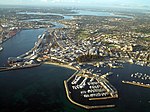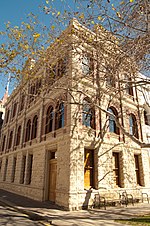Fremantle Fortress

Fremantle Fortress was the combined coastal defences protecting the harbour of Fremantle, Western Australia, since the mid-1930s and, predominantly, during World War II. The coastal defences of the Fremantle Fortress stretched along the coastline of Perth from Cape Peron to Swanbourne and also included installations on Garden Island and Rottnest Island. While the first coastal batteries of the future Fremantle Fortress were installed at Arthur Head in 1906, the military installations protecting the harbour were expanded in the 1930s, being eventually dismantled again by 1963. During World War II, Fremantle Harbour, guarded by the Fremantle Fortress, was home to the Fremantle submarine base, which was the second-most important submarine base in the Pacific War after Pearl Harbor. The coastal batteries were manned by members of the Royal Australian Artillery, the Royal Australian Engineers and the Volunteer Defence Corps. Apart from these men, members of the Australian Women's Army Service also served at the Fremantle Fortress. Of the former installations, the Oliver Hill Battery and its associated railway have been preserved, remaining a tourist attraction on Rottnest Island. Parts of the Leighton Battery, Buckland Hill, have been restored and its underground facilities are accessible. A bunker and one of the Panama mounts of the Peron Battery are also preserved and accessible.
Excerpt from the Wikipedia article Fremantle Fortress (License: CC BY-SA 3.0, Authors, Images).Fremantle Fortress
Rous Head Road,
Geographical coordinates (GPS) Address Nearby Places Show on map
Geographical coordinates (GPS)
| Latitude | Longitude |
|---|---|
| N -32.05 ° | E 115.73333333333 ° |
Address
Rous Head Road
Rous Head Road
6959 , North Fremantle
Western Australia, Australia
Open on Google Maps










